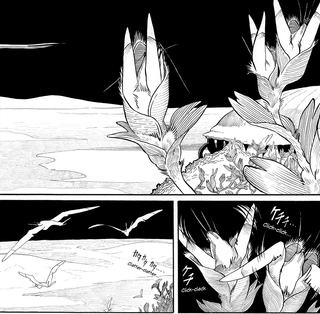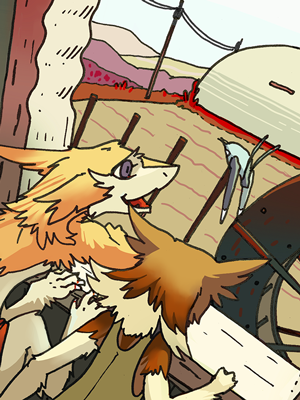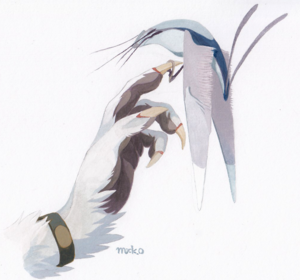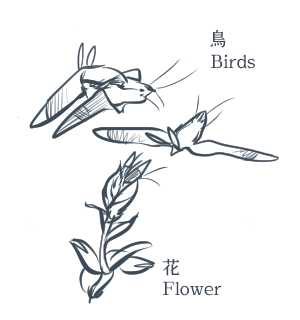Talyxian Flyers
Talyxian Flyers (タリクシアンの鳥・羽虫) is a blanket term within the Talyxian organism group which is attributed towards smaller sized, winged animals or detachable organs, both of which feature the ability to fly. In colloquial language, they are generally referred to with multiple, different names ranging from "bird", "flying bug", "fly", "butterfly", "bee" down to "humming bug", depending on their species type, size, shape, and ecology.
They are called with various names such as "bird" or "fly". A way how to call them depends on the region or each people's personal sense, not distinguished with a strict biological classification; Some people may call them "bird" while others may call them "fly". However, there is still a general trend in a way how to call them; a type which has a size as the palm is often called as a "bird", and a type which has a smaller sizer is often called as a "flying bug" or "fly".
There are two creatures which can be seen on page 2 of the manga, from Episode 1 "Gathering Herbs" which also belong to this type of creature.
Summary
As opposed to single organism living beings, they can be said to take up the form of a partial and detachable organ stemming from a different Talyxian creature, which acts as the parent organism for them. They are still able to travel freely from their base creature, however, it is still unclear if they, themselves, can be considered an independent life form.
They are capable of growing out from many kinds of Talyxian creatures (most of them are classified as “Settled” type, stationary and remaining in a fixed location), as an individual bud as part of the larger conglomerate of body parts. When they take flight away from the base organism, they will be “used” by other species creatures, in a very wide range of fashion.
Given that the T-Flyers themselves have little to no internal organs or reproductive ability, they are used as vessels or “vehicles” for other species and their creatures, and their life cycle will invariably come to an end due to various encounters or results depending on their purpose and the environments they find themselves surrounded by. Some creatures may use them as their seed carriers or pollinators, or even as remote parasitic organisms. A “used” flyer may be subsequently be reused by several creatures or even other Talyxian species. When this happens, they become mobile again after settling down and can be modified into a different flyer type entirely. There is even a creature which eats or intakes a flyer within their inner body in order to be used as their own organ. Due to this, as their ecology is extremely varied and dependant on the usage of other species which, in turn, make use of them, it is very difficult to pin down a specific methodology and guidelines.
Common flyers feature strong traits stemming from both Black and White Talyxians, and in fact, they are close kin to the Talyxian moles, biologically. Red flyers can be found inside of a flower which is grown from the Talyxian Rice Frog as their reproductive organ, but they are comparatively rare species, which parasitizes on Eltus organisms. These creatures can also be sometimes seen in brackish water areas.
Biology
Talyxian-flyer wings are paired in groups of minimum two, to a maximum of eight, and in shapes that range from insect-like to airplane-like wings. Also, species which feature no wings will not be referred to as "flyer", even if they have similar or identical biological nature with T-flyers. Most of them have a lightweight and firm carapace that come in colors which range from black to white. They also feature a wide variation in shape and pattern.
T-flyers generally produce a sound in the same manner as grasshoppers do, by rubbing their carapace or joints together, instead of making use of cries like Earth flyers do.
Generally, T-flyers share the same body shape under these conditions: they have grown on the same parent creature, and all emerge from their buds to fly off at the same time. However, if they have grown on different parent creatures, they will have different body shapes. Furthermore, even if they have grown on the same parent creature, if they each emerge during a different season, they will each display different body shapes. This system can be compared to that of a snowflake.
Most of the small-sized flyers fly with their wings and their movement is regarded to be similar to that of hummingbirds and insects. Large-sized flyers will travel while gliding as their large wings do not move about so much.
Some flyers may opt to just perform an unpowered flight at all times and will not show any reaction even if other life forms will attempt to catch them if roaming nearby. Meanwhile, some flyers may just flee away swiftly when they will have sensed a disturbance in the flow of air currents. The flyers which have an animal-like sensory organ, such as vision and hearing, are rather few in kind. Most of them will show a nervous, reflexive and botanical response which is similar to what sensitive plants do, such as moving their antenna in a twitching manner when it has been touched.
Most of the species of flyers do not have an organ which equates to that of a mouth. These species are not able to eat food and ingest new sustenance. They instead rely on the bank of energy that they have stored within themselves since emerging from a bud. When they consume all of their inner energy, it will signify the end of their lifespan.
Ecology

They generally grow out from an inner part of the flower which blooms upon their host creature. This state is similar to that of a bud. They will ‘eclose’ from a stationary bud form in order to transform and emerge as a mobile life form. Then, they will take flight away from the base organism. This sequence is fully expressed in page 2 of "Gathering Herbs", Episode 1 of Vilous manga.
However, as previously mentioned before, there are some exceptions which will not fly off from their base creature or their birthing flower. They will spend their lifetime within a different ecology from that of flight-capable flyers. Most pertaining to this type are Red Birds.
When flight-capable flyers have found a good place to land after traveling, they will proceed to bury themselves underground and stay there in order to sprout and grow their host creature, fulfilling the role of a “seed”, literally.
Some of these flyers may choose other creatures body surfaces instead of the ground and will infest into their body to parasitize them or assimilate with a seedbed creature. As an example, the carrion of Dondoko is one of the options for parasitic flyers. They will parasitize on its dead sprout and use it as their seedbed.
Some seedbed creatures may accept the invading flyer in order to get benefits for themselves; intaking a flyer within their inner body under the superior reign of their organism in order to turn the flyer into their own organ. In these cases, an intaken flyer will become a totally different species creature, or end up as a new part of organs which belong to a seedbed creature.
As such, mutations and variations which can occur during their life cycle have a greatly wide array of manifestation.
Aside from a few exceptions, flyers generally do not enforce reproductive behavior as long as they are playing their lifetime out in a flyer form state. Because their seed carrier role just means that their entire body consisting of themselves can be considered to be the seed of the host creature itself. Due to this, flyers do not perform reproduction with other flyers.
Due to the lack of a mouth structure and throat, they generally do not make sounds in the way which Earth birds do. Instead, they make a sound similar to the fashion of noisy insects, such as grasshoppers, by rubbing their carapace or joints. This is the same method Talyxian Wolves perform in order to make a sound, however, T-Wolves make a sound which is more akin to the sound of crickets.
For an actual example of T-flyer sounds, two flyers which can be seen in page 2 of "Gathering Herbs", Episode 1 of Vilous Manga, they were making rhythmic, clicking sounds "Click-Clack" and "Clatter Clatter".
Kind of species
As there is a greatly wide of the kind, type, and variant in Talyxian organism which can be considered as a flyer, it is very difficult to describe and classify strictly all kinds of them. However, there are still some easy classifications for the specific type which generally share certain and common features.
Some types of T-flyers have carapace which grants them tolerance to salt, similar to the same function of various shellfish creatures. Compared to normal flyers, the mutability which they could potentially cause happens in small frequency as long as they have not been given any chemical stimulus. These flyers generally have either one of these certain features: One which is able to travel so far as to reach the desert or one which does not act by autonomous purpose.
Within the Talyxian biome forests, there are also Red Birds which feature wings akin to moist petals, but most of them rarely go out of the forest area. Alternatively, some of them will not have the ability to fly and spend their lifetime parasitizing other creatures instead. Flyers which usually act only within Talyxian Forest areas feature only thin skin. Due to this, if they coincidentally drift near the vicinity of a salt lake, they will be weakened and fall down by being exposed to the sea breeze.
Relation with Eltus people

Because they generally originate from realms within the Talyxian biome, they are rarely seen near the inhabited areas of Eltus folk. However, as their travel course depends on the flow of wind, some of them may still drift to places where Eltus people take up residence and live.
Usage
As there is a wide variation in their shape, color, and pattern, they are popular as collectible items and souvenirs in many regions.
When Eltus people use wild flyer species and process them into specimens and decorative items, they will go through the process dubbed "trial by fire" on the flyer corpses, in order to bestow them a hygienically safe condition.
There is also a T-flyer usage which focuses primarily on observing their fun behavior; First, one must affix them with a string in order to avoid them from running away, and when someone will go nearby them, they will attempt to fly away, but end up just turning around in the range of the string's length.
Some people may want to keep them as a pet, however, most of the flyers are virtually impossible to be kept due to their ecology. In conclusion, such a thing would end in a very short term if attempted.
With regards to Southern Sieg who were living in the desert, flyers were known as a common resource for them, as their partners, the T-Dogs often found out and dug up flyers from within the sand.
As food
All wild species which belong to the Black Talyxian group generally have a risk of carrying infectious, biological threads, the same risk as T-Moles have. Due to this, flyers are not recommended as food all too often. Additionally, flyers which already flew away from their birthplace flower and traveled some distance will feature fibrous and stringy meat, as well as have a dried out mouthfeel, as they have lost their fat and energy. Due to this, wild species of flyers have a bad taste in most cases.
However, they are still able to be "cultivated" as a source of food. Harvesting them from a cultivated flower when they are still in a bud form and state of gestation just before eclosion in their flyer form, enables maintaining them as a safe food that keeps a good taste. Edible flyers harvested in this process are also known to be a good ingredient for pickling.
This cultivation technology is the same used as the method employed in creating sessile Talyxian Pigs, a common creature used as livestock in Gold Ring.
Useful Links
Start Vilous!
Enjoy the Stories!
Peek at the World!
Terms of Service

